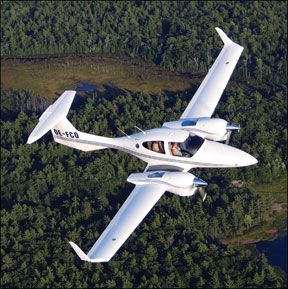Wh
Customers complain about Thielerts slow support, lack of ready parts supply and Diamond is apparently so irritated with Thielert that it has started its own engine
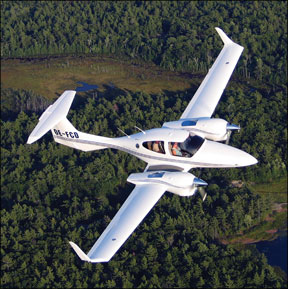
company to build the better diesel mousetrap. What went wrong here? In a market that appears so receptive to economical new technology engines, how could Thielert have stirred such ire?
To be sure, many of the Thielert diesels problems appear to be routine teething pains anyone in the aviation business would not only understand, but expect. Its unrealistic to imagine that new technology will take the field without significant bumps and setbacks. But the company doing the fielding has to jolly customers along with ready and unquestioning support and generous warranty response that sends the clear message that “were all in this together.” But customers complain that Thielert hasnt done this. “These guys,” one owner of a diesel-powered Cessna 172 told us, “have a lot to learn about customer service.” Customer service issues aside, Thielert is just now introducing the new-and-improved variant of the Centurion, the 2.0, which it says will correct the 1.7s deficiencies and offer an extended TBR to 2400 hours. Customers are receptive, but many say their patience isn’t infinite.
Our Findings
With growing curiosity, weve been covering the diesel revolution since it declared itself in 2002. With its 135-HP Centurion 1.7 diesel influenced by a Mercedes-Benz
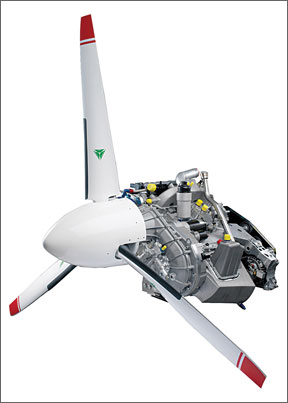
250
automotive design, Thielert led the charge, buoyed along by Diamonds willingness to adapt a new airframe-the Twin Star-to suit the diesel and to install the 1.7 in its existing DA40 single, creating the DA40 TDI.
Buyer response has been strong enough to have generated sales of some 350 twins and about an equal number of singles, or about 1050 Thielert engines for Diamond aircraft alone. In addition, Thielert has approvals to convert Cessna 172s and Piper Cherokees to diesel power, of which there a growing number worldwide. In October, Cessna announced it would offer the Centurion 2.0 as an option in new 172s.
To find out what owners think of these airplanes and engines, we published a query in our sister publication, www.avweb.com and we also reached out to numerous owners via e-mail and telephone. The results paint a less-than-flattering picture of the Centurion 1.7s reliability and, more worrisome, of Thielerts ability to support it. We asked owners to rate the airplanes and engines on performance, economy, value and customer support.
What emerged was a sharp-edged dichotomy. On the one hand, owners seem to love the Diamond airframes and generally give the company praise for customer support. And every owner we communicated with seems enthralled with the idea of economical diesel power. But the majority told us they found the reality of diesel reliability to be a disappointment.
The positives upfront: Owners like the diesels automotive-like ease of operation. It starts like a car and has a single-lever power control rather the three levers found in the typical GA high-performance aircraft. Moreover, owners tell us, Thielert hit the nail on the head with regard to fuel economy claims.
“Its very economical in terms of fuel consumption and has great range, as we have extended tanks,” wrote Paul Ponting, a diesel DA40 owner based in the U.K. A U.S.-based flight school owner, Dick Azar of Santa Teresa, New Mexico, has been operating a Cessna 172 diesel conversion for about a year. “Its exceptional,” he told us, “everybody wants to fly it.” Azar says his school will have to fly the airplane more to amortize the high cost of the conversion, but hes satisfied enough with the diesel to consider buying another. Vilis Ositis had this to say about his DA42: “I just love the plane. At this point, I don’t have many hours with it, but have spent an extensive amount of time learning about the engines, since I like to know how things work, this after countless problems (engine and airframe) with my Continental-powered Columbia.”
Minnesota-based Cary Mariash bought a DA42 last March, replacing an older Cessna 310. Hes flown 120 largely trouble-free hours and is thrilled with his purchase.
But “thrilled” wouldnt describe the majority of the diesel owners we spoke with. Most have experienced a myriad of minor problems, but enough major ones to keep the airplanes grounded for weeks running.
“I fly club DA40 diesels,” wrote Barry Kempster, another U.K. pilot. “They have been nothing but trouble from the time the first of the two new aircraft arrived 18 months ago. Theyve been AOG as much as theyve been in the air.”
Complaints about the Thielert engines-whether in DA40s, 42s or Cessnas-seem to consist of a combination of numerous small faults grounding the airplanes and major issues such as cracked cylinder heads requiring heavy maintenance or even engine replacement. There have been a number of inflight stoppages, including one on the DA40 owned by Paul Ponting, whos quoted above.
Heres a summary of some of our findings:
In 1600 hours, the owner of two diesel-powered Cessnas reported one inflight stoppage and one engine replacement due to oil leaks.
- Utah flight school with two DA42s replaced cylinder heads and two complete engines in about 2000 total flight hours.
- Midwest flight school experienced four precautionary inflight shutdowns in a DA42 in under 400 hours of flying
- South American operator had repeated cylinder head cracks and an inflight failure in a Cessna 172 that caused minor aircraft damage when the aircraft landed on a beach.
In June 2006, a diesel-converted Cessna 172 was lost after it ditched off the east coast of Canada following an engine failure. The pilot was rescued.
In March 2006, a diesel-converted Cessna 172 made a successful emergency landing after an engine failure in Florida.
- U.K.-based DA40 suffered an unexplained engine failure and the aircraft was damaged during the ensuing emergency landing.
In Copenhagen, a diesel-powered DA40 landed short of the airport after its engine quit for unknown reasons.
Maintainers complain about unrealistic labor hour allowances for repairs and about poorly organized technical documentation.
Delivery of parts and major engine components is slow.
Burrowing Deeper
For a more granular view of maintenance issues with the Centurion 1.7, we
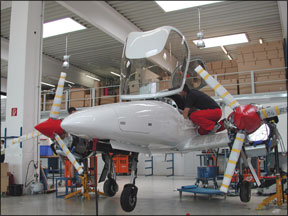
interviewed several owners in depth, including Utah Valley State College in Orem, Utah. The school has an extensive aviation program and was the launch customer for Diamonds DA42 Twin Star, which it has flown extensively in training.
Program director Mario Markides told us hes enthusiastic about Diamonds aircraft and believes the DA42 is robust enough for intense training operations. Like most owners we spoke with, he says hes cheering for Thielert to succeed with the diesels but believes the company has lots to learn. The college initially bought two DA42s and added two more later. The two original aircraft have accumulated about 2000 hours and have been plagued by cylinder head cracking bad enough to require engine replacement in one aircraft at the 500- to 600-hour point and cylinder head replacements in a second.
Parts and support from Thielert, says Markides, have been difficult. “I don’t think they understand how business is done in this country,” he said, a comment we heard many times. “They just don’t seem to have the parts and support for anything in North America. Its really lacking.” Another operator, European American Aviation in Naples, Florida, complained that Thielert doesnt understand that airplanes grounded for days at a time cost commercial operators big money.
As did other maintainers, Markides said Thielerts hours estimates for repairs simply arent realistic for the techs actually doing the work. “Theyre kind of a pipe dream. Theyre way off the mark for a general FBO,” he told us, something Thielert will need to fix. Further, owners and maintainers complain that Thielerts attitude
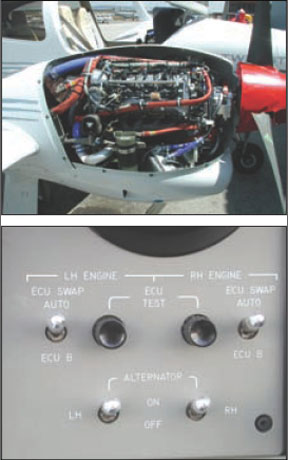
toward suggested improvements in parts, service, documentation and design is often arrogant and dismissive.
Mechanics tell us maintaining the Cessna conversions is somewhat easier because the installation is less encumbered by hoses, wiring and the tight cowling found in the Diamond airplanes. Nonetheless, service and reliability issues appear to be just as troublesome. A year ago, we reported on Stan Fetters conversion of two Cessna 172s, which he uses for his traffic reporting business in the Washington, D.C. area.
Some 1600 flight hours later, he has encountered numerous maintenance issues such as intermittent FADEC faults, oil leaks, parts supply issues and slow delivery on gearboxes, which must be changed every 300 hours.
Earlier this year, one of his Cessnas suffered a partial power failure when an induction hose came loose. The airplane was landed in a field without damage. A second engine was trashed by an oil leak that caused enough overheating to require engine replacement. Fetter reports that Thielert has been slow to respond to warranty claims on these issues and when he suggested better quality clamps on the induction hoses, Thielert was unresponsive.
When we asked Fetter if he was ready to wash his hands of Jet A piston engines once and for all, his reply surprised us: Not at all. Hes still enthusiastic and believes long term, the diesels will work out because of what he sees as proven economy claims. Like many operators, hes anticipating that the new Centurion 2.0 will deliver better reliability.
“Frankly,” Fetter told us, “if these things were a lot worse, they would still run rings around a Lycoming.”
Thielerts View
We contacted both the Thielert Group and Diamond Aircraft to review our findings. Both companies conceded that the Centurion 1.7 engines have had a rocky service
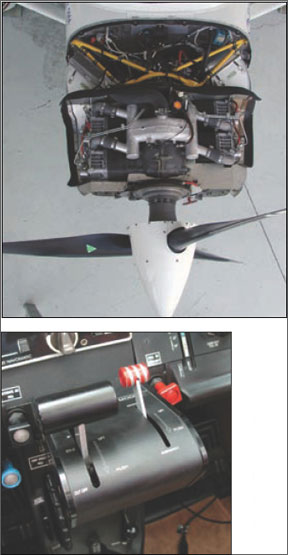
history, but that teething pains were expected. Thielerts Sebastian Wentzler told us that the company hasnt experienced many maintenance issues that it didnt expect or wasnt prepared for.
As for the engine failures we uncovered, Thielert told us that in 630,000 flight hours, the 1.7 engines have experienced 22 inflight shutdowns and two accidents, but no fatalities or injuries. That pencils out to about 3.5 shutdowns per 100,000 hours, which Thielert maintains is only one-third the rate of other piston aircraft engines. When we asked on what data this is based, Wentzler said it comes from FAA statistics. Thus far, weve been unable to substantiate what data Thielert is referring to. We simply don’t have credible failure rate data for avgas engines. In any case, failure rates are a potential minefield for several reasons, the most salient being hours flown estimates for the industry are all over the map. Second, what defines a failure? Are fuel-related issues not caused by the pilot an engine failure? How about mag failures in an avgas engine? Such rate studies can thus be a test case for apples-to-kumquat comparisons.
Wentzler told us because Thielert has available multi-parameter FADEC data, it can often determine exactly what happened in an engine stoppage and can thus define “stoppage” to exclude system-related causes. He concedes that if avgas engine manufacturers had FADEC data, they could do the same, reducing the stoppage rate by application of a sharper pencil.
Wentzler told us that early experience with the Centurion 2.0 indicates that its maintenance incidence and dispatch reliability will be improved. Wentzler also concedes that Thielert is aware of service and warranty response issues. “We see head-room to improve our response time. We are still initializing a service center network, but right now, they only have a little experience with our engines,” he told us. Thanks to continuing demand from Diamond and now Cessna, Wentzler says Thielert will improve service response. Superior Air Parts, which Thielert owns, is expected to figure in this effort.
Diamonds Reaction
Given all the complaints we uncovered, we asked Diamond if it has been satisfied with the Thielert powerplants. “The engines are we’ll matched to our airframes,” said Diamonds Peter Maurer, “and generally perform well.” Regarding reliability, Maurer, like Thielert, said developmental snags were expected. “As operators and maintainers gain experience…procedures are adjusted and the number of service difficulties diminish. This is a normal process, regardless of brand or product.”
Maurer added that Diamond obviously would like to see higher reliability and believes initial experience with the improved 2.0 has delivered better serviceability.
As for Thielerts field support, Maurer says it needs work. “To be blunt, we feel there needs to be much more effort put into the support of the product, especially with regard to quick AOG response. With our joint efforts, we expect these improvements in the near future,” Maurer told us.
But what about Diamonds Austro engine initiative? Doesnt this indicate profound dissatisfaction with Thielert? No, says Maurer, Diamond simply recognizes a business opportunity. “With many of our aircraft… in high utilization operations, there is a significant business component related to after-sales support, something we currently only participate in to a limited extent. Our ability to have more influence on the engine design and features-including warranty-are the main reasons for supporting such a project.”
Conclusion
In our view, and based on comments we heard from many owners, the Thielert engines seem to do we’ll at low hours and in casual use by private owners. Theyre less impressive in hard commercial or training use. Owners satisfied with Thielert engines are definitely out there, but our impression is many more arent happy with reliability. One high usage owner told us he often feels like hes trapped “in the Bermuda triangle between Diamond and Thielert.”
Based on this, we believe the diesel market remains Thielerts to lose. Diamond is Thielerts largest single commercial customer and when your best customer announces it plans to compete directly with you by building its own engines, thats a five-alarm fire, despite efforts by both companies to downplay their differences.
Were not privy to the details of obvious tensions between Diamond and Thielert, but the Austro Engine project indicates to us that the marriage is not going well. Diamond CEO Christian Dries has been openly critical of Thielerts service performance and has complained about late engine deliveries.
With more than 1000 diesels out there in Diamond aircraft, the next round of replacement engines will clearly belong to Thielert and these will be Centurion 2.0 powerplants, in which owners are investing considerable hope. Utah Valleys Mario Markides summed it up thusly: “We would be in trouble if there wasnt anything on the horizon.”
By extension, that applies to the entire idea of aerodiesels as construed in the current market. If the Centurion 2.0 flops, aircraft diesels will suffer a stunning setback. Although the inflight stoppages we uncovered are a concern, we think some perspective is in order.
We simply don’t know and cant reliably calculate how this rate compares to Lycomings and Continentals. It could be more or less-the credible data simply isn’t there, despite Thielerts claims, in our opinion. As the technology matures, we think reliability will inevitably improve. Our larger concern-and one evidently shared by Diamond-is lack of dispatch reliability and poor AOG support that has diminished the ownership experience. That, more than anything, threatens the success of diesels.
Still, Thielert has a remaining we’ll of good will in customers who really believe in diesels. Said John Grieff, whose diesel-powered Cessna 172 ended up on a beach in Belize with a failed engine, “This is a real dichotomy in my mind. I love the idea of diesel economy and I really applaud these guys for having the guts to reinvent the piston engine. Its just had a myriad of problems.”
Grieff is awaiting the installation of a Centurion 2.0 in his Cessna and hopes it will prove more reliable. Like many others who have bought diesels, hes adopted a wait-and-see attitude. And based on our research, so have we.

